Bread Machine Dinner Rolls: A Tested and Approved Classic
Sneak Preview: Make these classic bread machine dinner rolls with a bread maker. They are beginner-friendly and taster-approved. No bread machine? No worries! You can still mix the dough in a stand mixer or do it by hand. See the recipe notes for details.
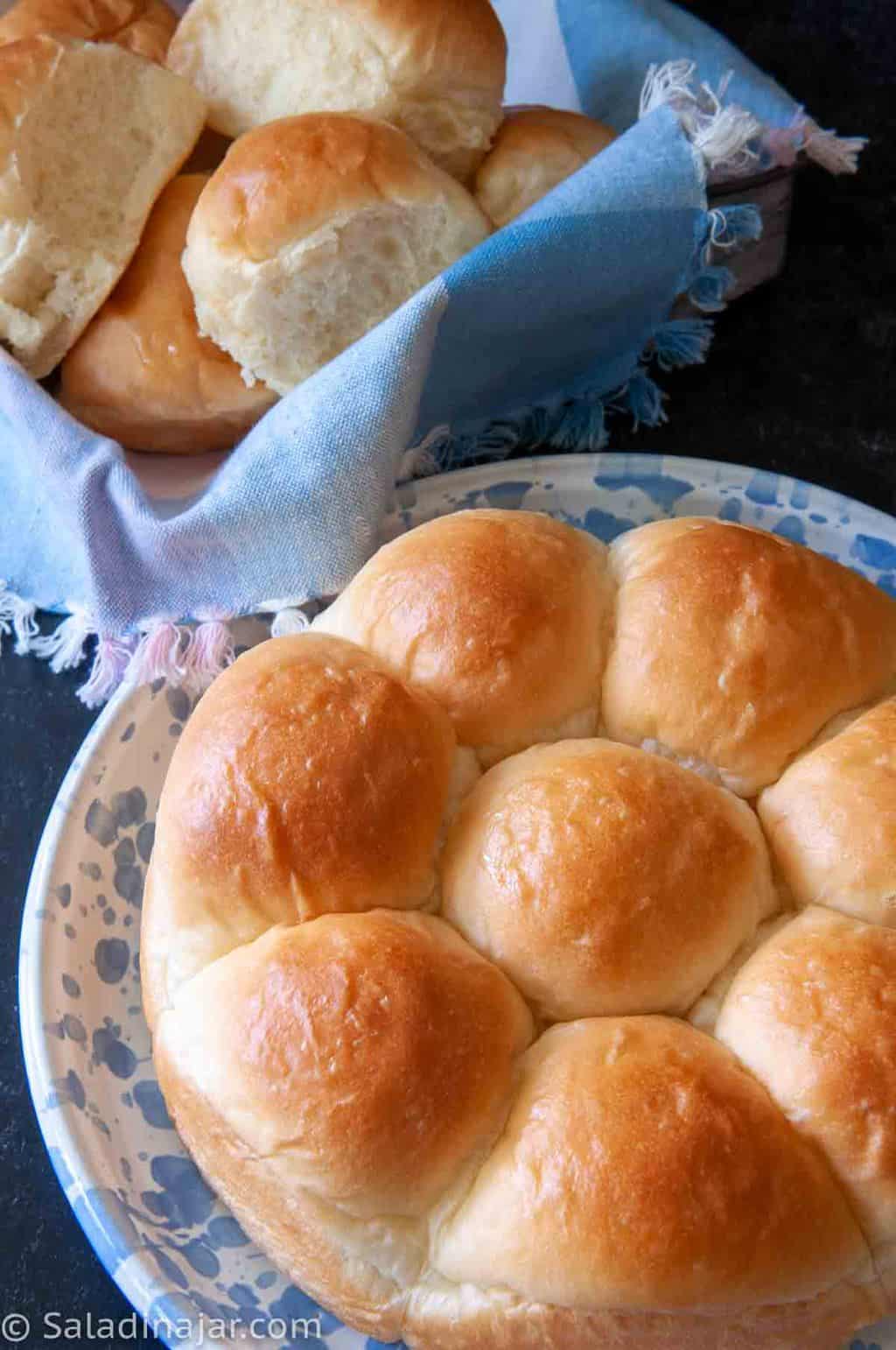
As an Amazon Associate, I earn from qualifying purchases.
Does anybody still clip recipes in this day of virtual newspapers, Pinterest, and gorgeous picture cookbooks?
I clipped this recipe out of our local newspaper in the ’80s, reportedly from the cooks at a local high school. I’m so glad to have their famous recipe for these scratch-dinner rolls.
Even though it wasn’t a bread machine recipe per se, the recipe converted beautifully so I could make them in my then-new bread machine. I was hooked.
A million and one batches later, I can honestly say this recipe has been “tested and approved.” Proceed with confidence.
Four reasons why you will cherish this recipe
- You don’t have to be picky about the ingredients. Of course, the richer and better quality the ingredients, the better the rolls. But I guarantee nobody will complain either way.
- Shape them however you like. I like to make balls because it’s fast. But if you have a better idea, try it.
- This is a basic roll recipe. Make them ahead to bake later, or add things like raisins or flavorings. Whatever you do, make them a lot, and don’t forget to share them.
- This roll recipe is ideal for a beginner. I’ve included tips and secrets to get you started on the right foot.
Happy Bakers Speak Up
“These are to die for! I can’t even tell you how many batches I have made because they go SO fast and I did share with a few. (very few) My inlaws live close and I shared with them and my gosh…. They went nuts over them, so that’s a must-share with them. Great recipe!!!“–SAMANTHA
Ingredients and Substitutions
- FLOUR: Unbleached flour is my first choice for a very scientific reason. I keep it in the flour canister on my countertop, making it easy to grab.
I’ve tried bread flour, white whole-wheat flour, and bleached flour. They all make great rolls. - MILK: Whole milk is best. The more fat in the milk, the better. If you have some other milk on hand, use it. Read below for options to use for lactose-free bread.
If you aren’t using whole milk, you could substitute one tablespoon of heavy cream for one tablespoon of milk. The liquid should not total more than 1 cup. - EGG: I use only “large” eggs in my bread recipes. Adjust the amount of liquid if you use a different-sized egg.
- SUGAR: The recipe calls for three tablespoons of sugar. Use granulated white sugar. Depending on how tight my pants feel that day, I often add only two tablespoons. Suit yourself. For a milder sweet taste, substitute honey. Remember that honey will add moisture, so you may need to add more flour on the fly with this surprising secret.
- BUTTER: The original recipe specified shortening, aka Crisco. After a few years of that, I switched to butter and never looked back. If you are out of butter or want lactose-free bread, use shortening as a substitute.
- YEAST: Again, the original recipe called for active dry yeast. I quickly exchanged the idea of waiting 10 minutes while the yeast dissolved for instant or bread machine yeast that doesn’t need to be dissolved. According to King Arthur Flour, active dry yeast no longer needs to be dissolved.
- SALT: Use table salt or sea salt. If you want to use Kosher salt, add about 1/4 teaspoon more. Salt is an important part of the package, so please don’t leave it out.
How Do You Use a Bread Machine To Make Dinner Rolls?
If you are a bread-maker newbie, read 6 Bread Machine Secrets You Need To Know. But, for now, here’s the quick answer.
Use the bread machine DOUGH cycle to mix up the dough, knead it, and let it rise. That means you will dump all the ingredients (except the butter) into your bread machine pan in the order listed in the recipe. Start the machine.
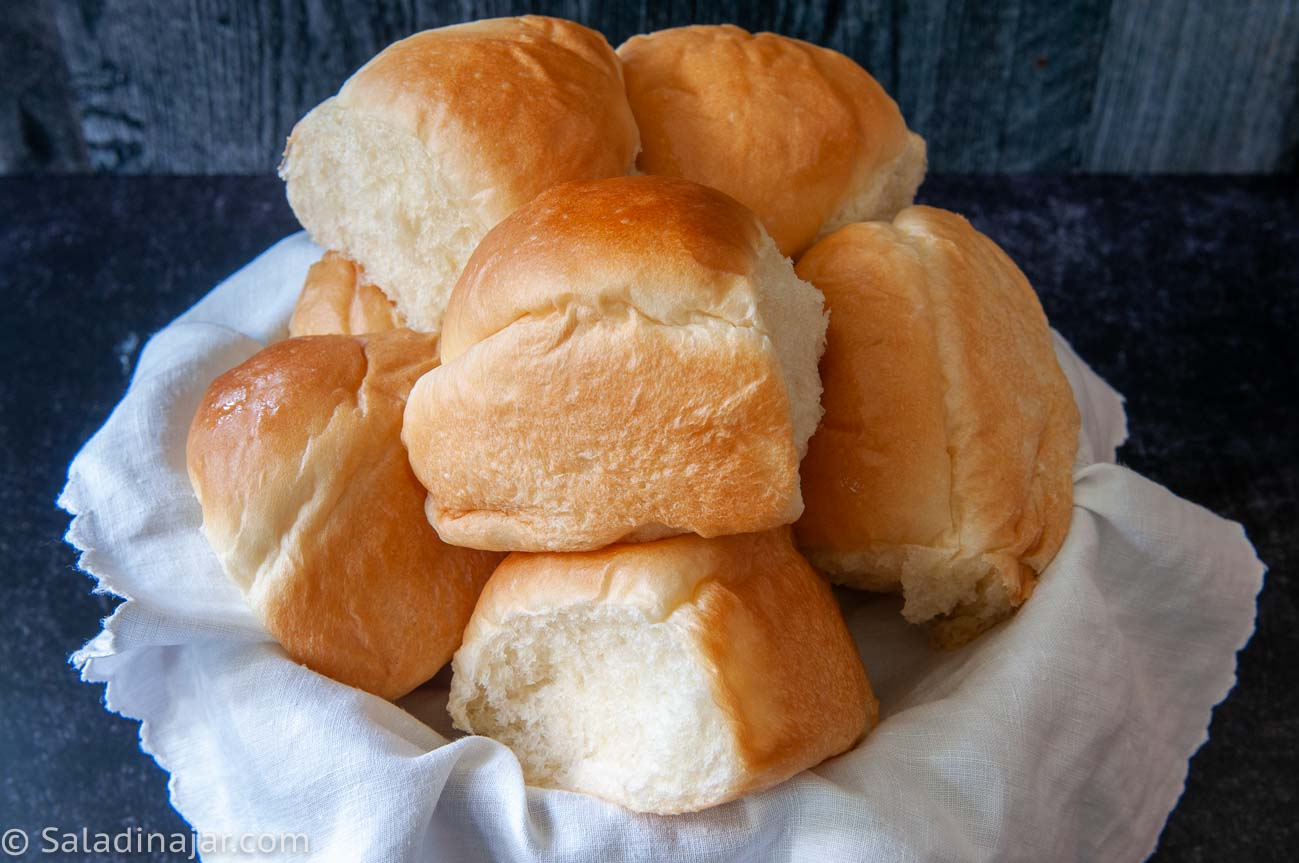
Related Post: The most important thing you should do when using a bread machine:
Check the dough at least twice by lifting the lid to take a peek. Do this after the machine starts to see if the paddles are correctly engaged. It’s also an excellent time to add butter. (See the recipe below.)
Check the consistency of the dough again 10-15 minutes into the dough cycle.
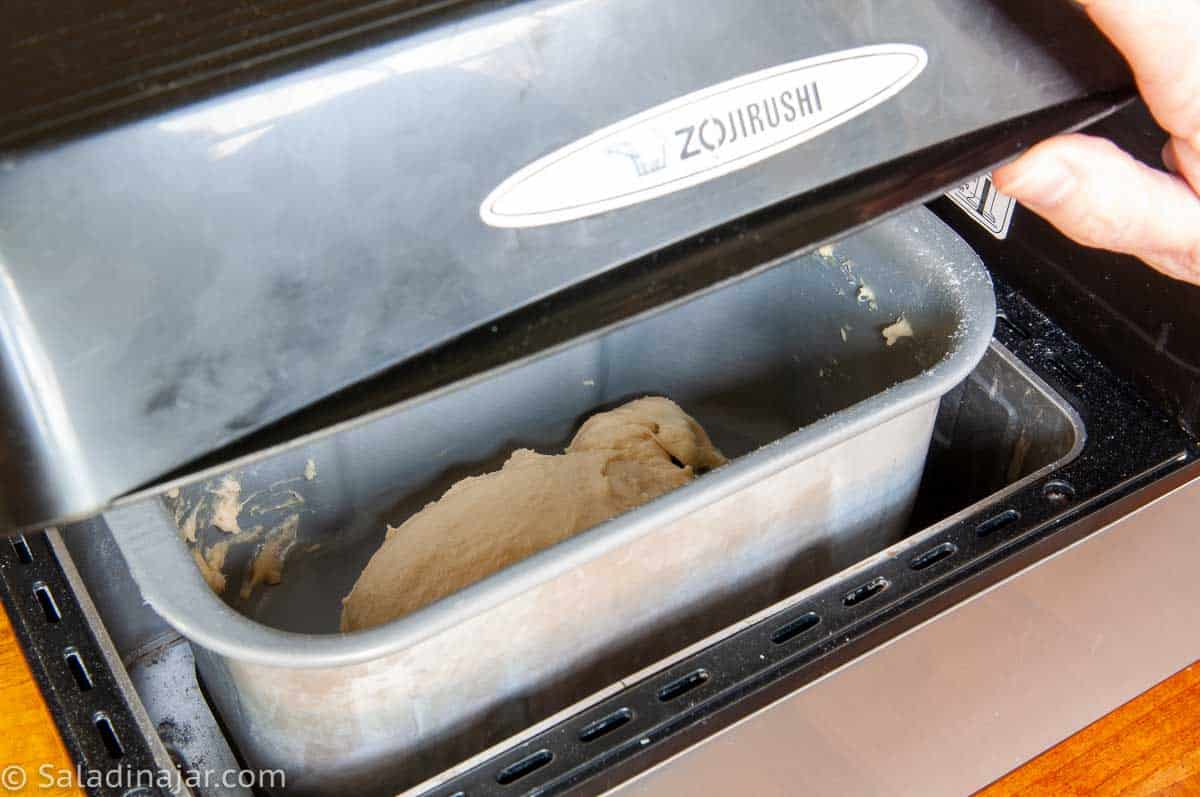
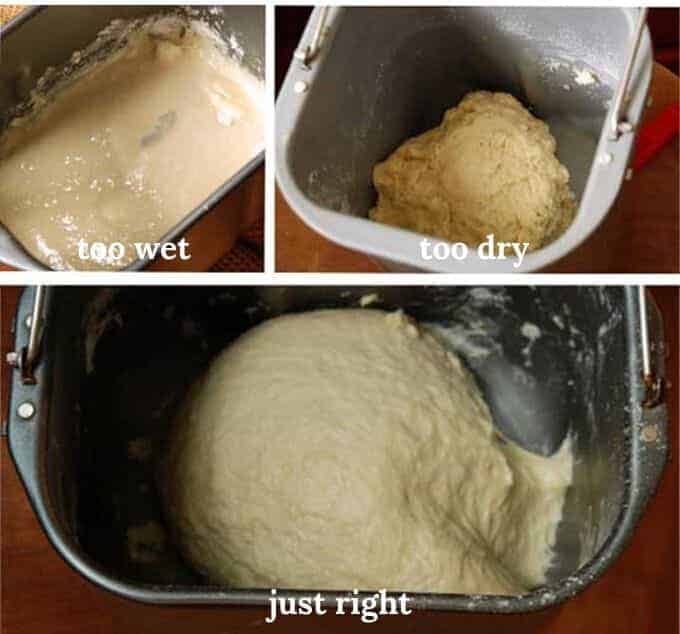
If your dough is too wet, add flour one tablespoon at a time. The dough should stick to the side, then pull away cleanly.
Conversely, if the dough is too dry, add one tablespoon of liquid at a time until the dough looks just right. See the video for another illustration of how your dough should look.
“The goal is for the dough to be shiny and elastic. It should stick to the side, then pull away cleanly.”
Once the dough cycle ends, remove the dough from the machine and shape it into balls. Place the dough balls into baking pans and cover them while they rise again. Bake rolls in your conventional oven.
Tips for bread machine dinner rolls
1. Weigh the flour.
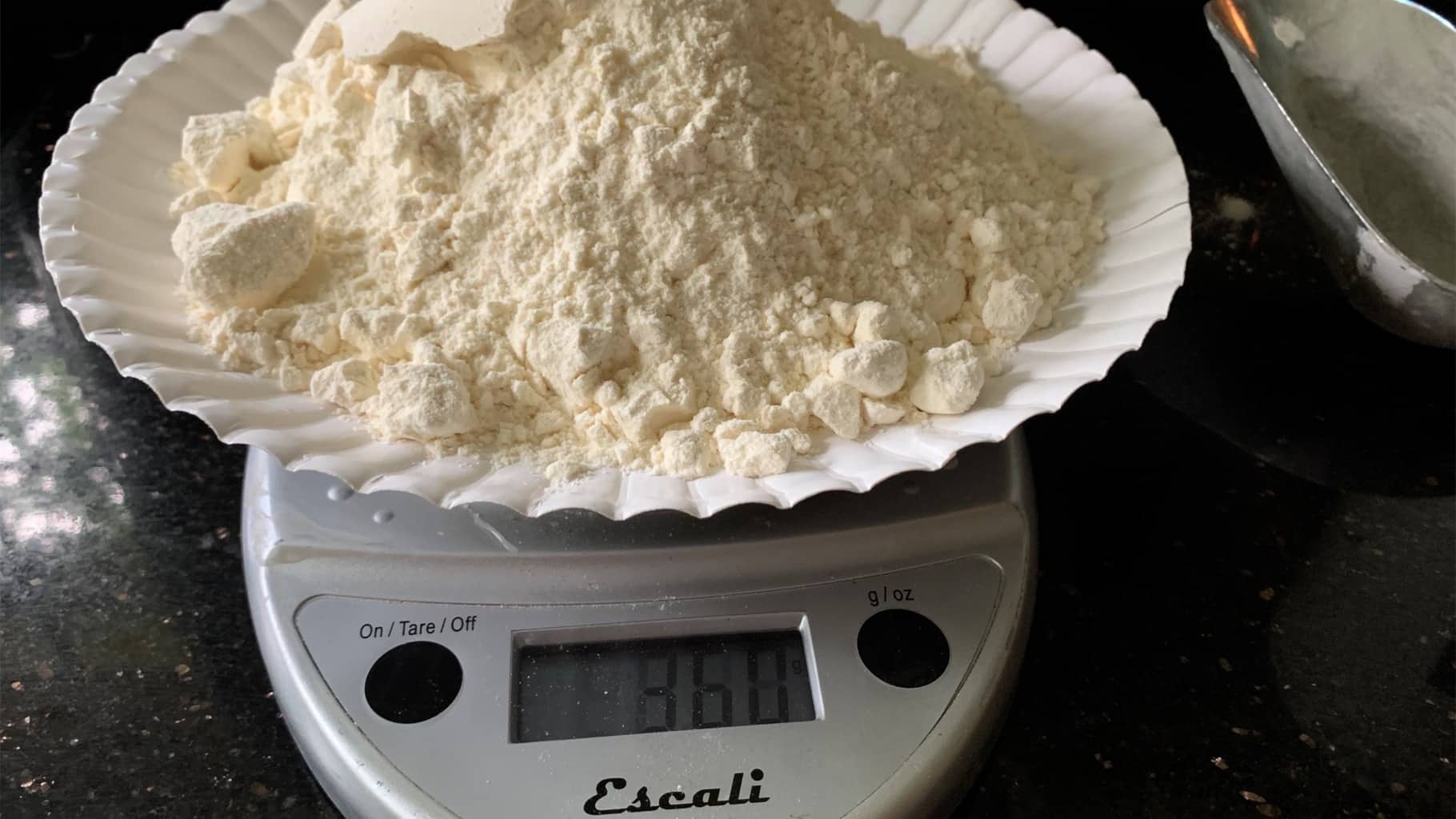
Weighing is more accurate than using a measuring cup. Now that I weigh the ingredients, I rarely add flour or liquid to my bread dough.
If you don’t have digital scales, fluff the flour with your scoop or spoon. Spoon flour into a measuring cup with a delicate hand. Level. Please don’t be a “scooper.” This practice inevitably leads to too much flour and heavy rolls.
2. It’s not normally necessary to warm the milk or eggs.
The friction caused by the kneading paddles will heat up the dough quite nicely. Not convinced? Poke a quick-read thermometer(paid link) into the dough at the end of the kneading phase. If it reads over 74˚F, the dough is at the perfect temperature for proofing correctly.
3. How to add butter to your bread machine.
If you have been baking with me for a while, you may recognize this as a change in my method of adding butter. I no longer worry about using warm butter. Instead, cut the butter into small pieces with a table knife or small paring knife.
Once you start the DOUGH cycle, the tiny pieces of butter will melt quickly because of the heat generated by the paddles in motion (otherwise known as friction).
4. Use a silicone baking sheet as your “floured surface.”
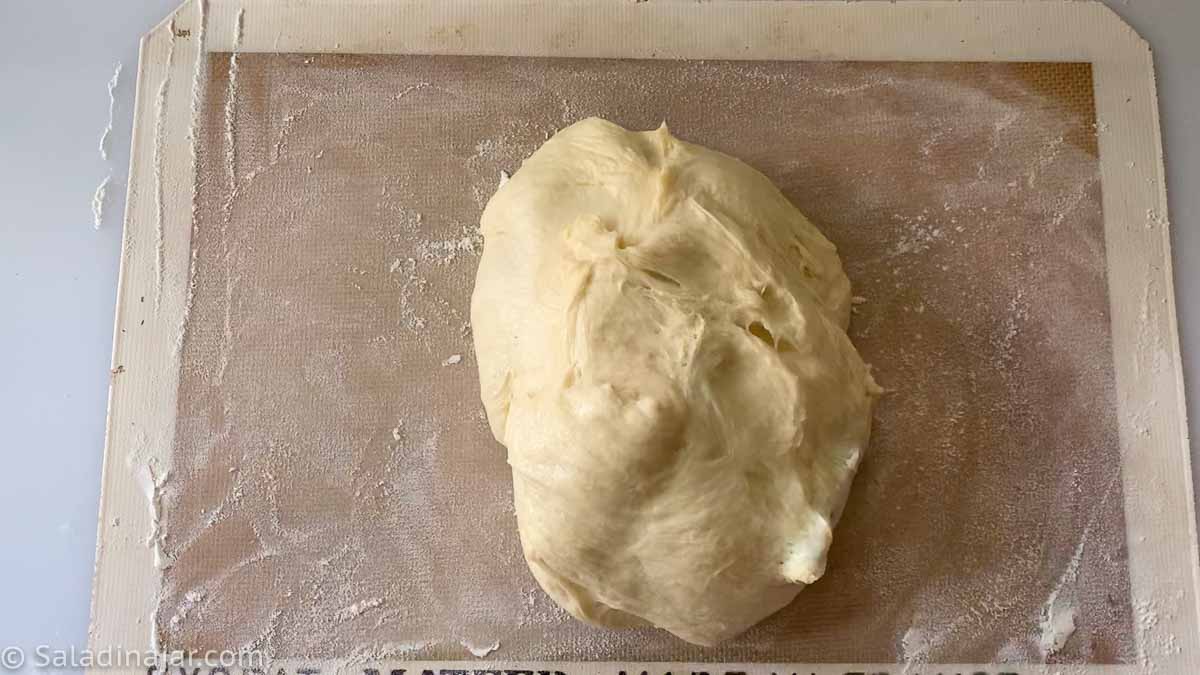
Silicone mats are the best platform for rolling out dough. Why? Because the mat is easy to wash. Throw it into the dishwasher.
Also, it doesn’t take as much flour to keep the dough from sticking. Try it, and you’ll see what I mean.
Speaking of flour, if the dough is too sticky for you to manage, add flour to your hands and more to the surface. Also, try coating your hands with butter when shaping the balls to prevent sticking.
5. Use colored pans to get a nice crust on the bottom of your rolls.
My pans of choice are the gold-colored pans. After that, I would choose a pan with a dark non-stick surface. The heavier the pan, the better.
Lightweight aluminum pans or disposable foil pans are slow to brown. If it is your only choice, place the rolls onto the lower rack of your oven.
6. Check for doneness with a thermometer.
Some may think, “I never saw my grandma use a thermometer.” I didn’t, either. Experience can take the place of a thermometer.
But if you’re a beginner or like to try new recipes, a thermometer can save you a lot of disappointment. It doesn’t have to be a fancy one. A quick-read thermometer with a long and skinny probe (paid link) works best.
When using a thermometer, delicately poke the probe from the side of the rolls into the middle to find the lowest temperature. Your rolls should reach 190˚F when ready to come out of the oven.
7. Don’t leave the rolls in the pan longer than 10 minutes after they leave the oven.
Because these rolls are so soft, leave them in the pan for a few minutes to cool and let them “set.” However, remove them after 10 minutes, or they will become soggy.
Place them onto a paper plate covered with a paper towel or a cooling rack. After about 20 minutes, I pull the rolls apart and pile them into a basket lined with a towel.
By this time, you will have people gathered around wanting to taste-test for you. I let them! Everyone will appreciate your efforts more when they are hungry.
Variations
Because they are plain, basic, classic dinner rolls, the dough is versatile. Make cinnamon rolls, raisin rolls, and more with the same dough.
Change the flour and make white whole-wheat rolls. Add rosemary and brown the butter to make a wreath with the balls for a holiday meal.
Because I never quit tweaking my recipes…
I adapted this super simple recipe by adding the Tangzhong technique. It might be even better because the rolls are flaky and stay fresh longer. The secret is in a liquid/flour paste that allows the baker to use less flour. However, it is slightly more trouble. You can see the recipe for my Favorite Dinner Rolls with the Tangzhong method here.
How to make Lactose-Free Dinner Rolls
Substitute water or non-dairy milk (such as oat or cashew) for the dairy milk. Crisco makes a good stand-in for butter, although I miss the buttery taste. Vegan butter is another possibility. Otherwise, follow the directions as written.
How to shape bread machine dinner rolls
I hope these pictures show you how to transform the dough into dinner rolls. Of course, there is more than one way to make a dinner roll.
Some people like to roll the balls on a floured surface. Others roll them between their hands. But I like the method shown in the video. Once you get the hang of it, it goes fast.
My best kitchen secret for shaping…
“Don’t worry about making perfect dough balls. If they are too perfect, people might think you bought your rolls from the grocery store.”
How To Make Classic Bread Machine Dinner Rolls Using the DOUGH Cycle
- Combine all the ingredients as described in the recipe. Select the DOUGH cycle, then START. Check on the dough as described earlier in this post.

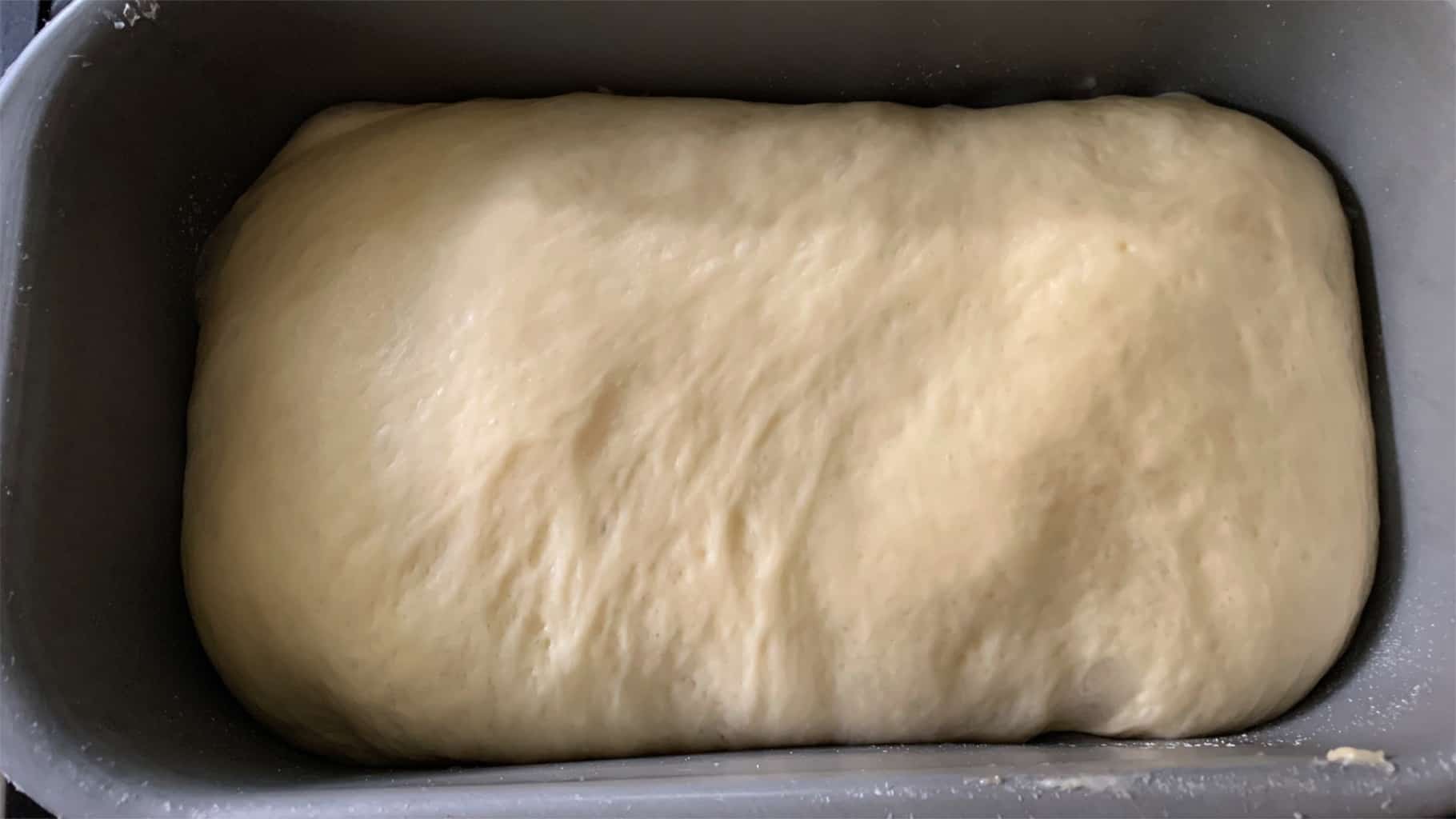
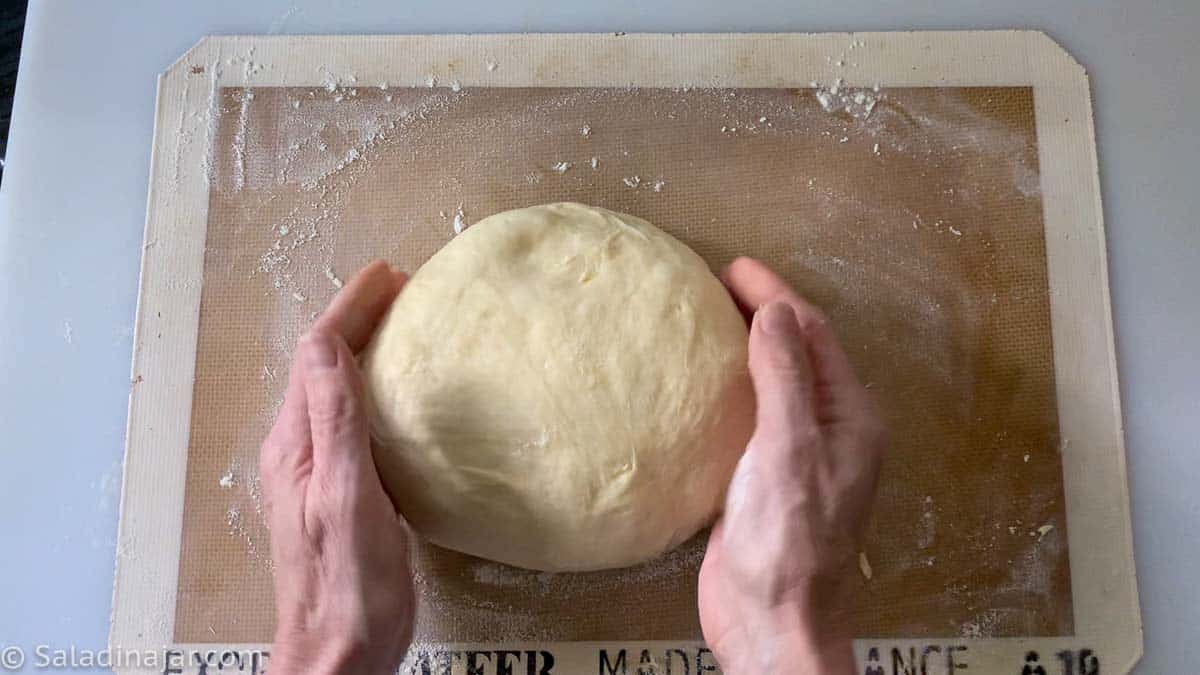
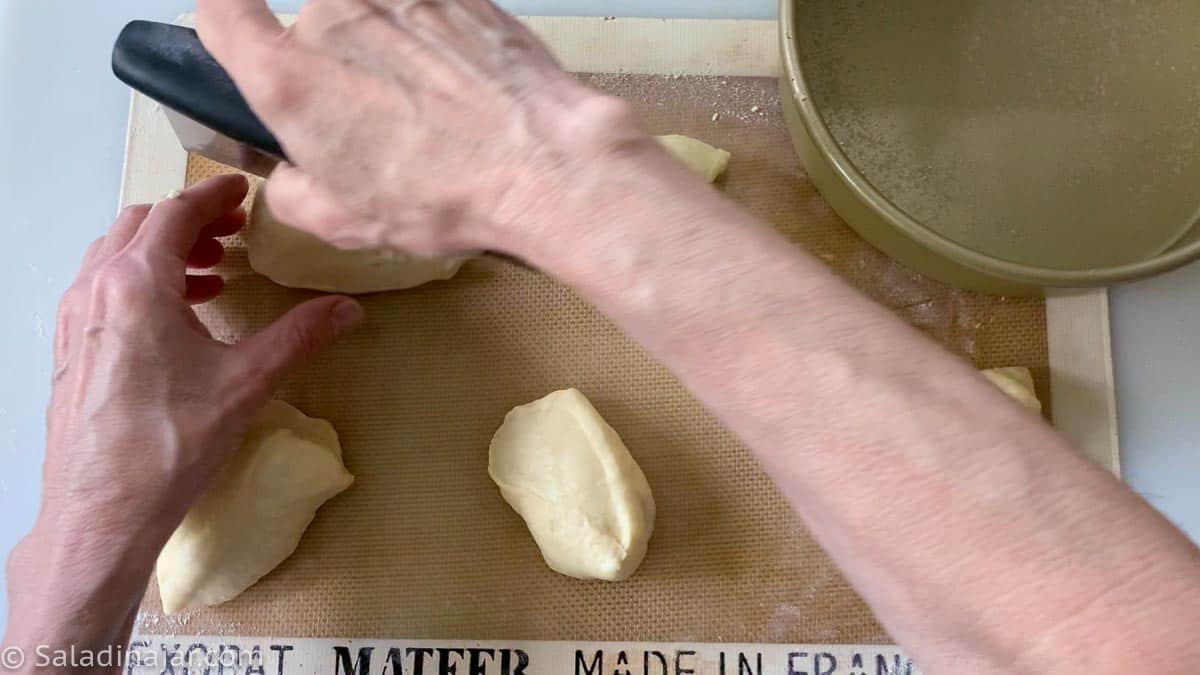
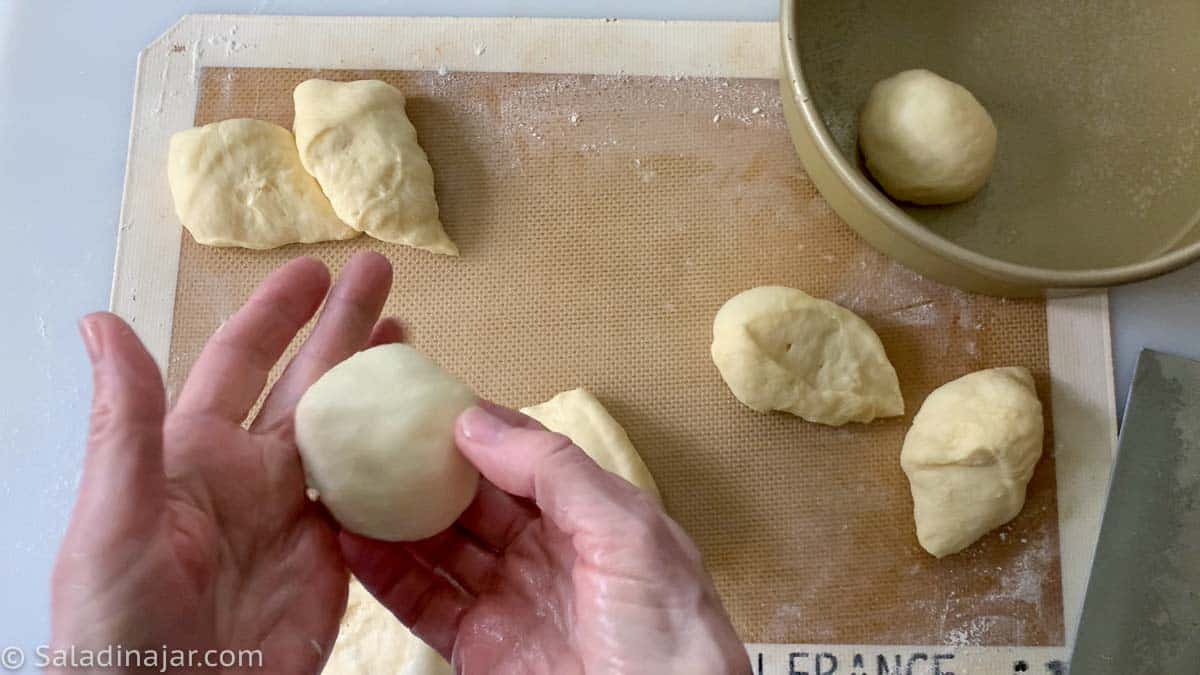
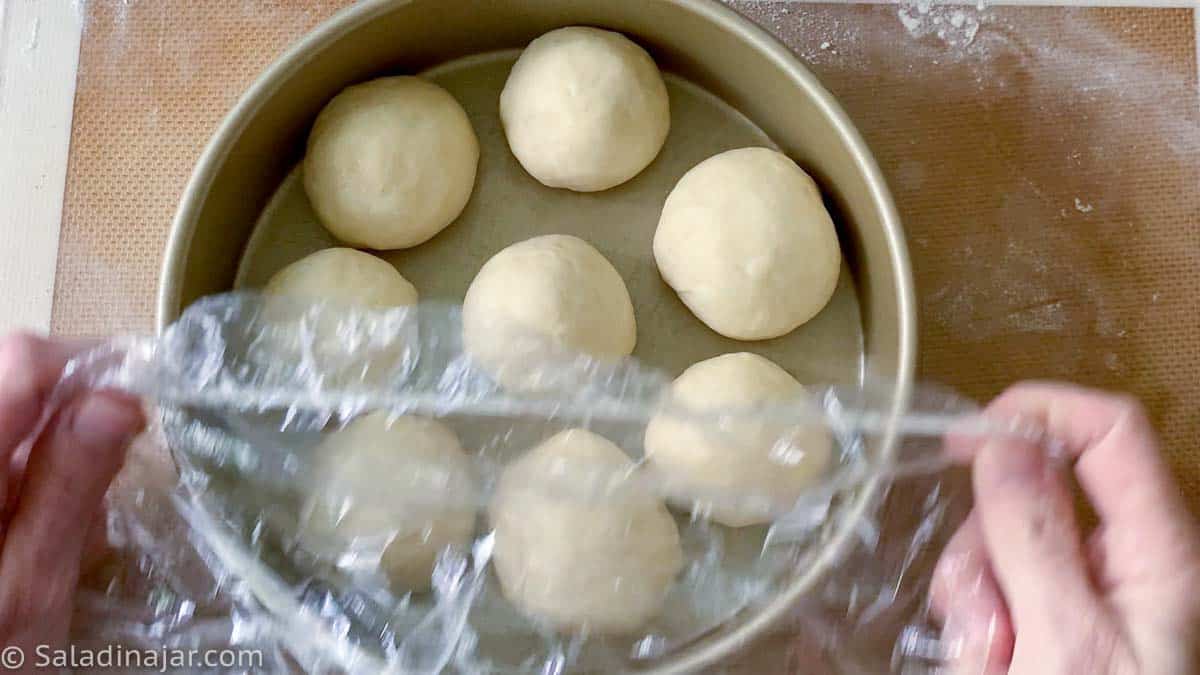
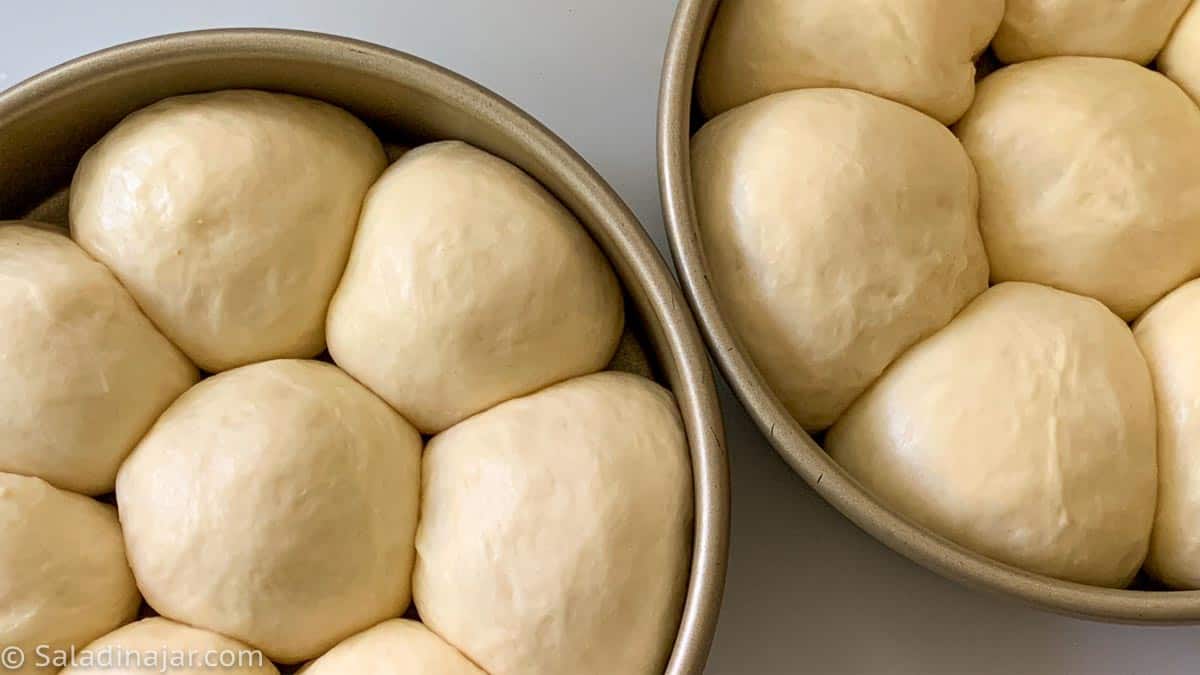
8. Bake at 350˚F (180˚C)for about 12-14 minutes or until golden brown and cooked throughout. The internal temperature should reach 190˚F (88˚C).
Check with a quick-read digital thermometer.(paid link) Turn out the rolls onto wired racks to cool so the bottoms won’t get soggy.
Frequently Asked Questions
Yes. Go ahead and shape the rolls and put them in the pan. Cover and place in the refrigerator.
The next day, take the rolls out of the fridge for 1-2 hours before you plan to bake them. Let the cold rolls come to room temperature and rise. When puffy, bake them in a preheated oven until golden brown.
Doubling a bread machine recipe is rarely good unless you mix the dough with a stand mixer or by hand. This is because a bread maker is limited in how much flour it can knead adequately. The size of most machines limits the recipe to around 4 cups of flour, but some are even less.
When making a double batch, there are two options.
#1 Option: If you have two machines, use them both. My second machine is old and was never good at baking bread, but it can still knead. Make a batch in each machine.
#2 Option: Make two batches in the same machine.
Assemble and start the first batch. When the kneading stops and the bread maker goes quiet after about 20 minutes, remove the dough to a large bowl. Cover it and move it to a warm place where it will continue to rise.
Clean out the bread machine pan and assemble a new batch in your bread machine. You can allow the second batch to complete the DOUGH cycle. Then, remove the dough and continue as usual.
If you are in a hurry, remove the dough from the second batch to another large bowl. Cover and set the bowl in a warmer place to rise. Often, my second batch will catch up to the first batch, and they will both be ready to shape almost simultaneously.
Yes. Double wrap the cooled rolls with plastic wrap, then a freezer-zippered plastic bag or aluminum foil.
Yes. After the dough finishes the dough cycle, shape the dough as desired. Freeze the rolls. Remove from the freezer and double-wrap the rolls. When ready to bake, remove the frozen rolls from the refrigerator and allow the dough to though and rise until puffy before baking per the instructions. Because these rolls have no preservatives, they may not bake quite as high as dough that has never been frozen.
1. Were the rolls allowed to rise long enough before you baked them? This is the number one cause of dense rolls, especially for beginners. Don’t pay attention to the clock. Please wait for the rolls to rise until they are puffy and almost double their original size.
2. Did you substitute whole wheat flour for white flour? Whole wheat usually produces a smaller roll that won’t be as light and fluffy as white. I recommend this recipe for Whole Wheat Dinner Rolls or these White Whole Wheat Rolls if you want to use whole wheat.
3. How did you measure the ingredients? Weighing is the most accurate way to measure flour. Measuring with cups often results in adding too much flour.
You can find everything you need to know about brown and serve rolls in this post.
Parting thoughts: If you have a recipe for bread made the traditional way, but you want to make it in a bread machine, I hope you’ll try it using the DOUGH cycle. Send me a picture and let me know how it went. I’ll celebrate the accomplishment with you, or we can troubleshoot together.
ADDENDUM: I’ve learned that I no longer need to warm the milk or the egg. The friction caused by the kneading paddles will warm up the ingredients in no time. Not convinced? Check the temperature of your dough at the end of the kneading cycle with a quick-read thermometer(paid link).
More Bread Machine Recipes and Tips:
- The Softest Bread Machine Dinner Roll Recipe
- How To Use a Bread Machine to Make Fabulous Bread
- 6 Bread Machine Secrets You Need To Know
- Cinnamon Rolls with the Tangzhong Technique
Recipe Help at Your Fingertips: For questions or suggestions, email Paula at saladinajar.com. If you need help, I’m happy to troubleshoot via email (faster than leaving a comment). Attach pictures and as many details as possible for the best advice.

Classic Bread Machine Dinner Rolls
Rate this recipe
(5 stars if you loved it)
Video
Ingredients
- 1 cup (227 g) milk, cool
- 1 large (50 g) egg
- 3 tablespoons (36 g) granulated sugar
- 1 teaspoon table or sea salt
- ¼ cup (57 g) unsalted butter, finely chopped
- 3 cups (360 g) unbleached all-purpose flour
- 2 teaspoons bread-machine or instant yeast
Instructions
- Place 1 cup (227 g) milk, cool, 1 large (50 g) egg, 3 tablespoons (36 g) granulated sugar, 1 teaspoon table or sea salt, 1/4 cup (57 g) unsalted butter, finely chopped, 3 cups (360 g) unbleached all-purpose flour, and 2 teaspoons bread-machine or instant yeast into your bread machine pan in the order listed. Select the DOUGH cycle and press START.
- Check the dough at least twice during the mixing and kneading phase by lifting the lid to take a peek. The first time, look immediately after the machine starts mixing to ensure the paddles are engaged correctly. The dough should start to form a ball. Look again 10-15 minutes into the DOUGH cycle to assess the consistency of the dough. For most recipes, the dough should stick to the side, then pull away cleanly.If your dough is too wet, add flour one tablespoon at a time.Conversely, if the dough is too dry, add one tablespoon of liquid at a time until the dough looks just right. Read more about this surprising secret to success with a bread machine here.
- When the dough cycle finishes, the dough should be doubled in size. If not, leave the dough in the bread machine a few more minutes until you can punch two fingers into the dough and it fills in gradually. If it doesn’t fill in, it has risen too much. If the dough bounces right back and the dough fills in immediately, then it needs to proof (rise) a little bit longer. (This may happen if your kitchen is cold.)
- Pull dough out of the machine and onto a floured surface. Lightly knead the dough to remove any large bubbles, and form it into one large ball. Divide in half, making 2 balls. Divide each of those balls into 8 equally-sized lumps.
- Make a ball from each piece of dough by pulling the dough toward the bottom while turning the dough (see video) or use whatever method works best for you.
- Arrange balls into 2 well-greased 8 or 9-inch round or square pans (non-stick is better) and cover with a tea towel or a cheap shower cap. Place in a warm spot until almost doubled. (I put mine in the microwave where I have already boiled a cup of water for 5 minutes to make it warm and steamy.)
- Heat your conventional oven to 350 °F (180˚C).
- Bake in the oven until golden brown, usually about 12-15 minutes. Rotate to get even browning. The internal temperature should reach 190˚F (88˚C).
- Within 5-10 minutes, dump baked rolls out of the pan and let cool on a rack or paper plate so they won’t get soggy from the steam they produce. Brush with melted butter if desired.
Notes
- To make this recipe in a heavy-duty stand mixer: Add ingredients to the bowl in the same order. Turn on LOW to mix until all ingredients are moistened. Then, using a dough hook, turn the speed to 2 or 3. Continue beating/kneading until dough becomes smooth and elastic (about 5-10 minutes). Cover and allow to rise in a warm place. Deflate dough gently and shape as indicated in the recipe.
- If making by hand: Combine all ingredients into a shaggy ball in a large bowl. Turn dough out onto a floured surface. Knead with your hands until the dough becomes smooth and elastic. Kneading will likely take 10-20 minutes, depending on your experience. Place the dough ball into a greased bowl. Cover and allow to rise until double. Deflate the dough gently and shape as indicated in the recipe.
- Please note: If you only have active dry yeast, use 1/4 teaspoon more than called for in the recipe. It no longer needs to be dissolved first, but you can if you prefer.
Equipment
Nutrition
All images and text ©️ Paula Rhodes for Salad in a Jar.com



Paula Rhodes, owner
As a retired home economist, I created Saladinajar.com to share my belief that you don’t have to be a chef to find joy in creating homemade food worth sharing. Bread machines (used in an unconventional way), homemade yogurt, and quick microwave recipes are my specialty.